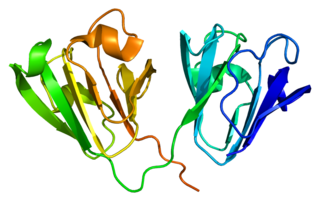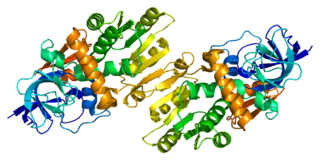
Thyroid hormone receptor alpha (TR-alpha) also known as nuclear receptor subfamily 1, group A, member 1 (NR1A1), is a nuclear receptor protein that in humans is encoded by the THRA gene.

Gamma-crystallin D is a protein that in humans is encoded by the CRYGD gene.

60S ribosomal protein L7a is a protein that in humans is encoded by the RPL7A gene.

Beta-crystallin B2 is a protein that in humans is encoded by the CRYBB2 gene.

Crystallin, gamma C, also known as CRYGC, is a protein which in humans is encoded by the CRYGC gene.

Beta-crystallin B1 is a protein that in humans is encoded by the CRYBB1 gene. Variants in CRYBB1 are associated with autosomal dominant congenital cataract.

Gamma-crystallin B is a protein that in humans is encoded by the CRYGB gene.

Beta-crystallin A3 is a protein that in humans is encoded by the CRYBA1 gene.

Gamma-crystallin S is a protein that in humans is encoded by the CRYGS gene.

Beta-crystallin A4 is a protein that in humans is encoded by the CRYBA4 gene.

Quinone oxidoreductase is an enzyme that in humans is encoded by the CRYZ gene.

Beta-crystallin B3 is a protein that in humans is encoded by the CRYBB3 gene.

Gamma-crystallin A is a protein that in humans is encoded by the CRYGA gene.

Lens fiber membrane intrinsic protein is a protein that in humans is encoded by the LIM2 gene.

59 kDa 2'-5'-oligoadenylate synthetase-like protein is an enzyme that in humans is encoded by the OASL gene.

Absent in melanoma 1 protein is a protein that in humans is encoded by the AIM1 gene.

Cell migration-inducing and hyaluronan-binding protein (CEMIP), formerly known as KIAA1199, is a protein that in humans is encoded by the CEMIP gene. CEMIP has been shown to bind hyaluronic acid and catalyze its depolymerization independently of CD44 and hyaluronidases. Such function has also been validated in mice.

High mobility group nucleosome-binding domain-containing protein 3 is a protein that in humans is encoded by the HMGN3 gene.

Glycoprotein hormone beta-5 is a protein that in humans is encoded by the GPHB5 gene.

Protein moonlighting is a phenomenon by which a protein can perform more than one function. It is an excellent example of gene sharing.
























